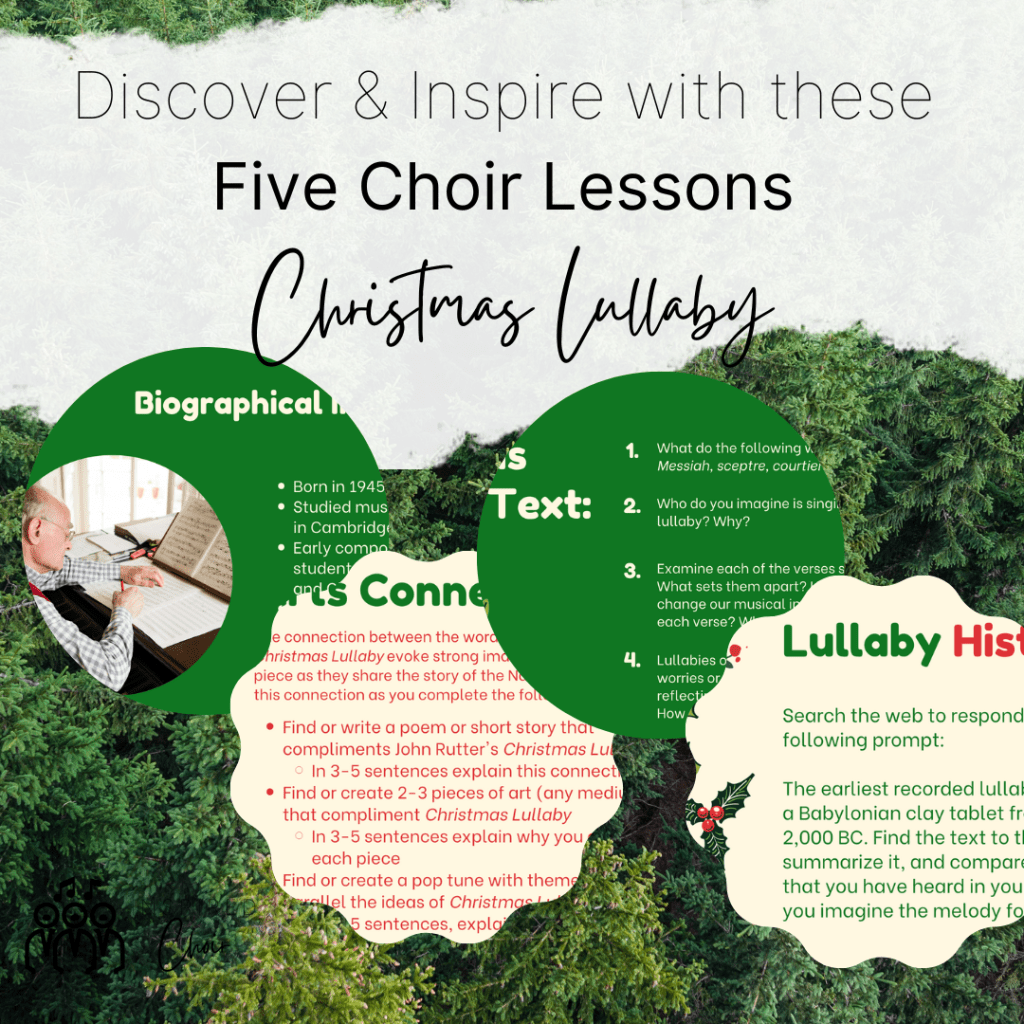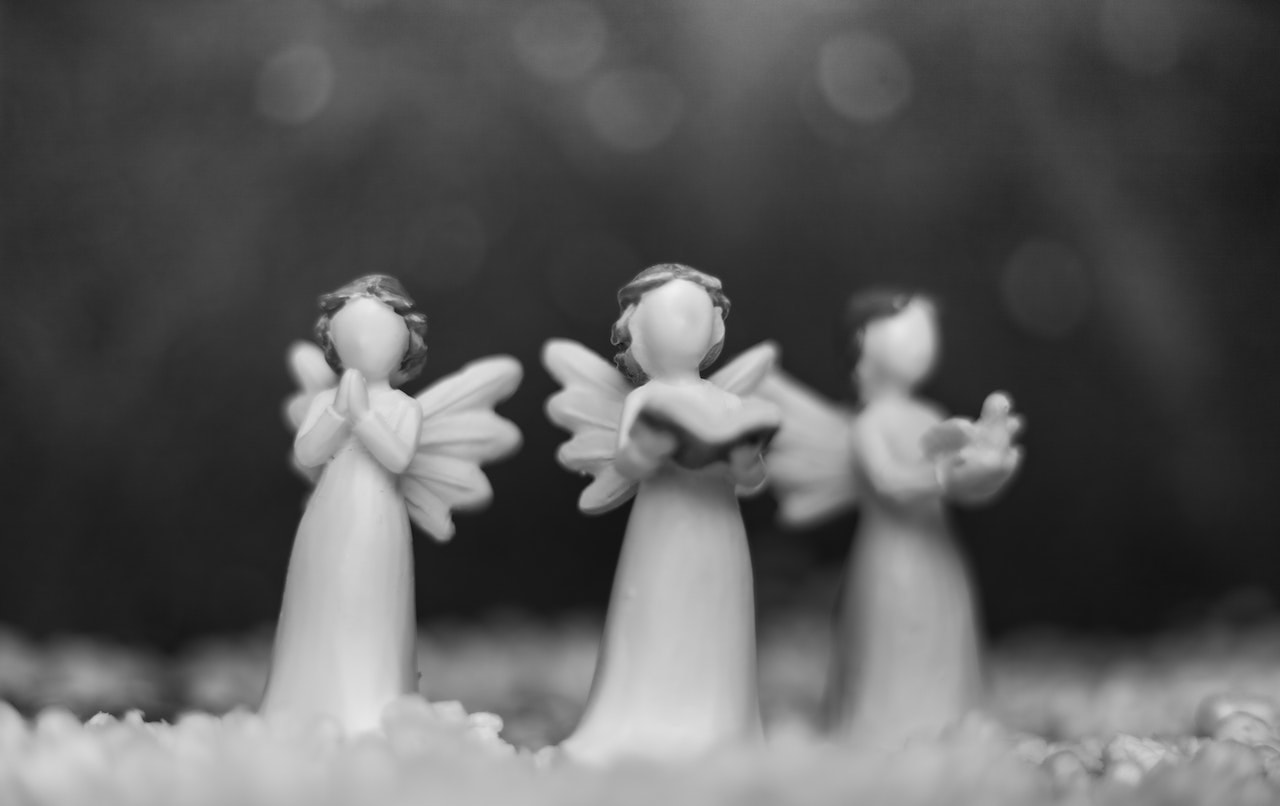A Deep Dive into John Rutter’s Christmas Lullaby
We at A-State are just two weeks away from our second annual Sounds of the Season concert! This year, we are so excited to be collaborating with a local group, The Diamond Brass Band. We will be performing three combined pieces with all of our choirs and the brass band, including the classic Christmas Lullaby by John Rutter.
In this post about Rutter’s Christmas Lullaby, I share the following:
- John Rutter Composer Bio
- An Introduction to British Choral Tradition
- The Origins of Lullabies
- The Culture of Lullabies
- Christmas Lullaby Teacher Resources
Before reading, take a listen to the Cambridge Singers and City of London Sinfonia’s performance of this timeless piece here.

“Angels are Singing”
Christmas Lullaby by John Rutter is a beautiful carol that is deeply rooted in British choral tradition. In this post, I share a bit about the iconic British composer, examine the good and bad elements of British choral tradition, dive into the origins of lullabies, and look at the way mothers around the world have used lullabies for thousands of years.
All About Composer John Rutter
John Rutter values choral singing as central to our humanity and sense of community. In a 2017 interview, he discussed the importance of learning how to be in harmony with other humans through choir, then taking that harmony into the world. “Choral music is not one of life’s frills,” he shared, it is essential.
Born in 1945 in London, Rutter was drawn to music at a very young age. (Read the most wholesome biography written by the composer on his website here). His musical and compositional skills were nurtured through his education. While still an undergraduate student, he published his first composition, Shepherd’s Pipe Carol. (Personally, I’m a little annoyed at how good this piece is for being a first publication).
Rutter is also known for founding the Cambridge Singers, an English mixed-voice chamber choir. They have produced an impressive list of albums, many of which are Christmas themed.
Describing himself as “50% composer and 50% songwriter,” Rutter attributes his style to his classical British influences David Willcocks, Edward Chapman, and Charles Wood, as well as to classic American songwriters like Jerome Kern and Stephen Sondheim and pop musicians including the Beatles. Although specific choirs have commissioned much of his work, Rutter has generally written with the amateur or student choir in mind. This is why so much of his work, including Christmas Lullaby, is accessible to most ensembles.
Here are a few of my favorite Rutter choral pieces, all performed by the Cambridge Singers under the baton of the composer:
- For the Beauty of the Earth – The first Rutter piece I ever taught 🙂
- Wexford Carol – Irish Traditional Hymn arranged by Rutter
- Donkey Carol – A Sweet Carol that serves as a great introduction to 5/8 meter

An Introduction to British Choral Tradition
British choral tradition is rooted in the British monarchy and the Anglican Church. The monarchy founded the chapel royal in the 11th century, and the country has been home amateur and professional ensembles of all kinds since then. Beginning in the 17th century, composers like John Blow and Henry Purcell created lavish choral anthems for coronations and other royal ceremonies; in the 18th century choral societies inspired by Handel and Haydn ruled; and today England is home to some of the most well-known musical groups including the King’s Singers, Tallis Scholars, and The Sixteen.
Mainstays of British tradition include cathedral locales, chapel choirs including professional adults and children, amateur singing choral societies, and choral festivals dating back to the 18th century. Composers like Handel, Purcell, Tallis, Byrd, Gibbons, Vaughan Williams, Britten, and Rutter are well known for their contributions to the choral tradition.
Recent efforts to diversify choral music in England have pointed out the structural racism and sexism of British choral tradition. Nearly every well-known British choral composer is a white male. With a bit of digging, we can find great music in the British choral tradition from women and composers of color. Here are a few examples:
- The March of the Women by English composer and suffragette Dame Ethel Mary Smyth
- Summer Is Gone by British composer and conductor Samuel Coleridge-Taylor
- Ave Maria by violist and composer Rebecca Clarke who sang for Ralph Vaughan Williams alongside Gustav Holst
- Peace on Earth by the prolific composer and performer Errollyn Wallen. Having composed 22 operas in addition to many orchestral, chamber, and vocal works, Wallen was the first black woman to have a work featured in the British Proms.

Where Do Lullabies Come From?
The earliest recorded lullaby comes from a Babylonian clay tablet from around 2,000 BC. When we think of modern lullabies, we often think of sweet sounds and even sweeter texts. This was not the case with the earliest lullabies. Ancient lullabies often warned children not to anger the gods or asked for protection from evil spirits, echoing mothers’ worries of the day.
There are two explanations for the development of the word “lullaby.” The first is that it derives from the Middle English words lullen and bye, meaning to lull one who is near. Second, folk etymology links the word to the child-soul-stealing demon Lilith, deriving “lullaby” from “Lilith-Abi” which is Hebrew for “Lilith, begone.”
As society developed from ancient times, mothers continued to worry about their children’s safety in the night. So although many tunes were soothing, many lyrics to popular lullabies regarded danger, death, and kidnapping. (Think about the lyrics to “Rock-a-bye-baby”…there’s some anxiety and trauma there for sure.)
Lullabies serve a variety of purposes. For example, scientists have found therapeutic value in these sweet bedtime songs. Lullabies help calm heart rates, relax muscles, and reduce blood pressure for babies. Additionally, lullabies can serve as a form of therapy for the singer and help to nurture caregiver bonds.
Although the primary function of lullabies is to help a baby sleep, another function is to let the singers speak. Rivka Galchen hypothesizes that this might be why lullaby lyrics tend to be a bit dark: “One way a mother might bond with a newborn is by sharing her joy; another way is by sharing her grief or frustration.” She hypothesizes that as we sing about sad moments, we’re putting out into the universe that sadness has already been here. No need to bring us any more.
Although John Rutter’s Christmas Lullaby does not carry through the darkness of traditional lullaby lyrics, the composer did utilize a melancholy tone during the verses and a lilting triple meter throughout. Additionally, the refrain highlights the baby’s mother with a reflective “Ave Maria.”
What We Can Learn from Lullabies
Analyze the lyrics of a lullaby and you likely will be able to learn something about the person singing and the culture from which they come. Often, caretakers use lullabies to share or strengthen cultural practices, introduce cultural roles, or educate the listener. They also frequently convey the caretaker’s fear of loss or separation.
A Gaelic lullaby “Ba, Ba, Mo Leanabh Beag” comes from the era of the potato famine in Ireland and Scotland. Written by a mother in the Scottish Highlands, the lyrics mention hopes and fears for the child, her inability to feed it well, and the soft potatoes.
The lyrics of a Judaeo-Iraqi lullaby that is hundreds of years old reflects the social situation of women during the composer’s time in her culture. She writes “I am a stranger…I have no friends in this world…and the husband is absent.” At the time, women in her culture would move in with their in-laws and were not allowed to leave the house without their husbands. Singing to the child would likely have been the mother’s only place to vent her frustrations.
Many lullabies convey warnings to the sleeping children about the natural environment. For example, a lullaby sung in western Kenya by the Luo people warns children to stay quiet at night: “Rock, rock, rock. The baby who cries will be eaten by a hyena.”
Beasts of all kind eating children is a common theme within many lullabies around the world, mirroring a caretaker’s fear of loss. A Russian lullaby warns children to stay quiet or a wolf will eat you; a Brazilian lullaby wards off a child-eating alligator; a Spanish lullaby warns about the bogeyman; a Haitian lullaby warns of child-eating crabs; and a Turkish lullaby sings of black birds eating a crying baby.
Lucky for us, Christmas Lullaby conveys no such warnings. Instead, it tells the story of the Christmas Nativity and highlights the relationship between Mary and the baby Jesus.

Complimentary Pieces
Want to listen to other pieces like Christmas Lullaby? Or planning a concert and need some programming ideas? Here are a few complementary pieces!
Enjoying the Nativity Scene?
- Arranged by Jace Saplan, Nu’oli for SATB div. wishes Glad Tidings and carries with it a rich history and context.
- Stacey Gibb’s Mary Had A Baby for SATB opens with a trio of solos and continues with a improvisatory and free spiritual style.
- On This Night by Dave and Jean Perry: Written so well for beginning choirs, this three-part treble with piano and optional handbells is so accessible and sweet.
Other pieces I’ve programmed with Christmas Lullaby this winter season:
- Quest of the Kings arranged by Jacob Narverud
- Winter Sun by Don MacDonald
- We Toast the Days by Linda Kachelmeier
- Tom Gentry’s Barbershop arrangement of Jose Feliciano’s Feliz Navidad
- The full Winter 2022 Choir Program Roundup

I’d Love to Hear from You!
Have you sung or conducted Christmas Lullaby with your choir? How do you think the piece connects to British choral tradition? What other Rutter carols have you performed? How much of the origins of lullabies did you know? Do you have any other favorite choral lullabies? Let me know in the comments below!
Christmas Lullaby Teacher Resources!
FREE Christmas Lullaby Reading Comprehension Worksheet
Reading Comprehension Worksheets pull five key points from the blog post above and ask singers to consider the musical decisions they can make with the info from this post. Fill in the form below and get a link to a folder including the Winter 2022 Post Worksheets immediately!
Christmas Lullaby Lesson Plan Bundle
Check out the Inspired Choir Shop for the Christmas Lullaby Lesson Plan Bundle. This bundle includes the following five minute lesson plans, all with connections to National Standards and SEL Competencies:
- An Introduction to the Life and Work of John Rutter
- Lullaby Histories Bell Ringers
- Text Interpretation Prompts
- Arts Connections Project
- Musical Concepts Flashcards


















